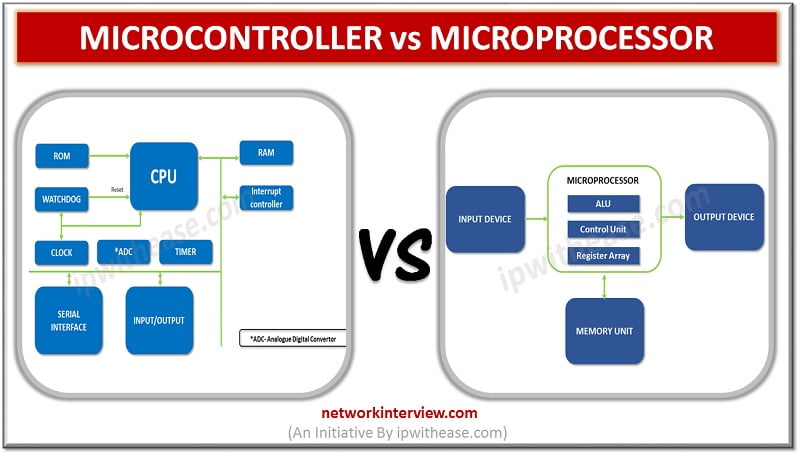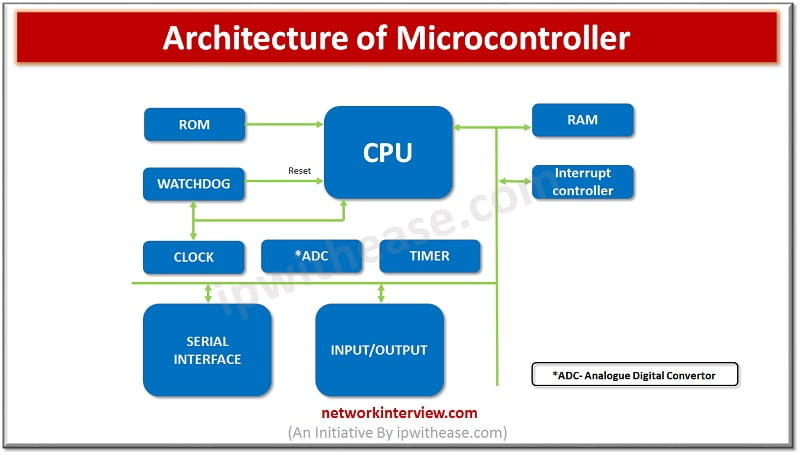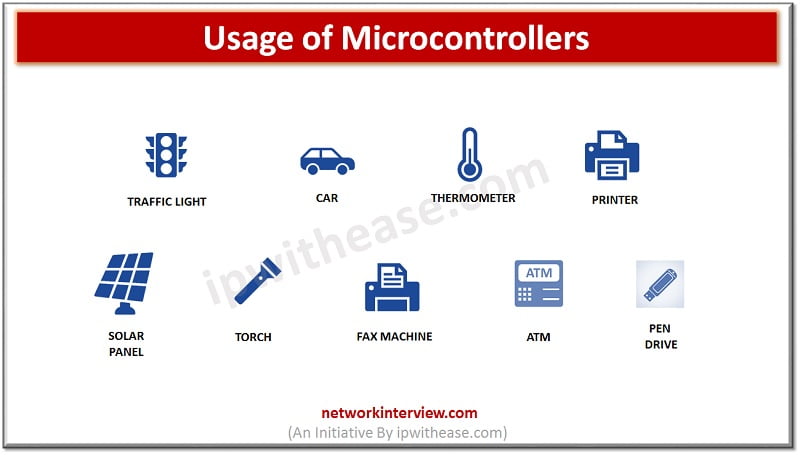
Microcontroller vs Microprocessor: Detailed Comparison
Microcontroller and Microprocessor both are integral part of computers and other components such as automobiles, telephones, appliances etc.
In this article, we will understand the differences between the two and about its usage.
Microcontroller
Microcontroller’s history is dated back to 1960s. The invention of MOSFET (metal-oxide-semiconductor field-effect transistor) also known by term “MOS transistor’. It was invented by Mohamed M. Atalla and Dawon Kahng at Bell Labs. It is a small system or computer on a single metal oxide semiconductor IC (Integrated Chip). It contains a CPU, memory, and Input/Output peripherals.
Another name for Microcontroller is ‘On-Chip microcomputer’
It is also known as embedded controller or microcontroller unit (MCU) – they are found in vehicles, Home appliances, medical devices, vending machines and so on. These are miniaturized personal computers made to control small functions of larger components.
If you look around you will find microcontrollers are functioning all around you such as microwave oven microcontroller sense door closure before popping popcorns, at traffic light signal to turn on / off lights at specified intervals etc.

Characteristics of Microcontroller
- Slow speed of operation.
- Uses a micro CPU using lower frequency.
- Peripherals (Timers, counters etc.) are embedded in chip.
- Suitable for bit wise operations.
- Less expensive.
- Boolean operations supported.
- Majority used in real time applications.
Pros & Cons of Microcontroller
- Good for small and dedicated applications.
- One time programmable.
- Ease of application development.
- Ease of design and deployment.
- Can’t withstand high voltage.
- Not suited for parallel tasks.
- Complex architecture.
- Limited RAM.

Microprocessor
Microprocessor is also known as ‘Heart of Computer system’. It is an electronic component inside a computer or in other words a ‘Self-contained single chip microcomputer’. It has a central processing unit (CPU) on a single IC (Integrated Chip) having non-volatile programmable memory, input / output capabilities.
A microprocessor can be configured to perform a task or a series of tasks. Most microprocessors operate at the clock speed between 1 and 40 MHZ.
Microprocessor is a brain of a computer and it comprises of Arithmetical and Logical Unit (ALU), Control Unit and Register Array. ALU unit is responsible for performing all arithmetic and logical operations on data received from input device or memory. Register acts like an accumulator (temporary fast access memory location) for data processing and control unit is responsible for controlling the flow of data throughout the systems.

Categories of Microprocessors
Microprocessors can be categorised into three types as per there architecture as under: –
RISC – Reduced Instruction Set Computer – Simplification of instruction set for computers to reduce execution time. Examples are Power PC: 601, 604, 615, 620, DEC Alpha: 210642, 211066, 21068, 21164 etc
CISC – Complex Instruction Set Computer – Reduction in number of instructions irrespective of number of cycles per instructions. Examples are IBM 370/168, VAX 11/780, Intel 80486 etc.
Special Processors – is a third category which is made to perform special functions such as Maths Coprocessor, Input/output processor, and Transistor computer.
Characteristics of Microprocessor
- Microprocessors work at very high speed.
- They are smaller in size.
- Microprocessors are programmable.
- Microprocessors are low costs due to integrated circuit technology.
- Power usage is very less due to usage of metal oxide semiconductor technology.
- Reliable, failure rate is very low.
- Lower heat generation as semiconductor devices emit very less heat.
Comparison Table: Microcontroller vs Microprocessor
Below table summarizes the difference between Microcontrollers and Microprocessors:
Function | Microcontroller | Microprocessor |
| Definition | It is a small system or computer on a single metal oxide semiconductor IC (Integrated Chip). They are used to handle tasks that control one or more external events or systems. | A computer processor is a programmable device having ALU (Arithmetic Logic Unit) ,Control unit on a single integrated circuit . Also known as Logic chip |
| Features | Smaller circuit, ideal for compact systems, lower cost , less power consumption, high clock speed, 8-bit, 16-bit, or 32-bit | Cost is high as compared to Microcontroller, Memory and I/O components are externally connected, power consumption is high, don’t have power saving feature, low clock speed, 32-bit, or 64-bit |
| Architecture | Comprises of a chip with embedded inside it – Flash memory Timer, I/O port, and serial bus interface | Comprises of Central Processing Unit (CPU), Bus and Memory (RAM & ROM) connected externally |
| Applications | Microcontrollers are used in calculators, Gaming machine, Traffic light control, Military applications , Home appliances etc. | Microprocessor are used in Computers, Smartphones , transportation industry, instrumentation, Office automation and communication etc. |
| Drawbacks/ Limitations | Can’t interface with high power devices, complex structure, can do limited executions parallelly, used in micro equipment’s | Limited data size, don’t support floating point instructions, heats up easily, |
| Examples | Altera, Atmel, Cypress Semiconductor, ELAN Microelectronics Corp, EPSON Semiconductor. | MC68000 Motorola, AMD, Intel. |
Download : Microcontroller vs Microprocessor Comparison Table.
Quick Facts:
Intel 4004 was a 4-bit CPU released in 1971 by Intel. It is the first CPU on one chip.
Continue Reading:
Microcomputer vs Supercomputer
Tag:comparison



